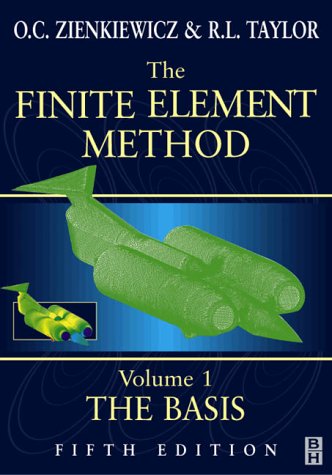O. C. Zienkiewicz, R. L. Taylor9780750650496, 0-7506-5049-4, 0750650559, 0750650508
Table of contents :
Contents……Page 7
Preface……Page 15
1 Some preliminaries: the standard discrete system……Page 17
2 A direct approach to problems in elasticity……Page 34
3 Generalization of the finite element concepts. galerkin-weighted residual and variational approaches……Page 55
4 Plane stress and plane strain……Page 103
5 Axisymmetric stress analysis……Page 128
6 Three-dimensional stress analysis……Page 143
7 Steady-state field problems – heat conduction, electric and magnetic potential, fluid flow, etc…….Page 156
8 ‘Standard’ and ‘hierarchical’ element shape functions: some general families of C0 continuity……Page 180
9 Mapped elements and numerical integration – ‘infinite’ and ‘singularity’ elements……Page 216
10 The patch test, reduced integration, and non-conforming elements……Page 266
11 Mixed formulation and constraints – complete field methods……Page 292
12 Incompressible materials, mixed methods and other procedures of solution……Page 323
13 Mixed forumation and constraints – incomplete (hybrid) field methods, boundary/Trefftz methods……Page 362
14 Errors, recovery processes and error estimates……Page 381
15 Adaptive finite element refinement……Page 417
16 Point-based approximations; element-free Galerkin – and other meshless methods……Page 445
17 The time dimension – semi-discretization of field and dynamic problems and analytical solution procedures……Page 484
18 The time dimension – discrete approximation in time……Page 509
19 Couple systems……Page 558
20 Computer procedures for finite element analysis……Page 592
Appendix A Matrix algebra……Page 636
Appendix B Tensor-indicial notation in the approximation of elasticity problems……Page 642
Appendix C Basic equations of displacement analysis (chapter 2)……Page 651
Appendix D Some integration formulae for a triangle……Page 652
Appendix E Some integration formulae for a tetrahedron……Page 653
Appendix F Some vector algebra……Page 654
Appendix G Integration by parts in two or three dimensions (Green’s theorem)……Page 659
Appendix H Solutions exact at nodes……Page 661
Appendix I Matrix diagonalization or lumping……Page 664
Author index……Page 671
Subject index……Page 679







Reviews
There are no reviews yet.